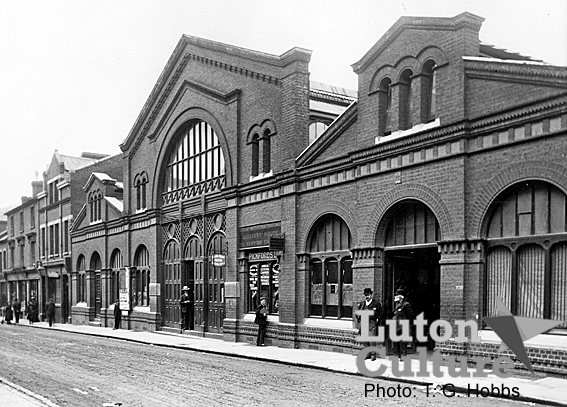Luton Plait Halls
Current Location
Classification

Like the Corn Exchange, the Plait Halls were to play an important role in World War 1 Luton, first as a requisitioned storage point and then, from March 1915 in the case of the Waller Street hall, as a YMCA recreation centre for soldiers billeted in the town.
The Waller Street hall became a well-used venue offering concerts and, even more popular, friendly sparring with gloves among the troops, all purely for the sport.
As with the Corn Exchange, the Plait Halls were opened amid much ceremony by Earl Cowper, the Lord Lieutenant of Bedfordshire, on January 18th, 1869.
Two foundation stones had been laid in March 1868 - The Luton Times of Tuesday, March 17th, 1868, said one foundation stone, inscribed March 16th, 1868, was laid amid celebration by Alfred Phippin Welch, of Hart Hill House, representing Luton's straw trade. A second stone inscribed with the date March 11th, 1868, was laid by Chairman Mr W. T. Pledge on behalf of the Luton Local Board of Health.
At the time of the opening, The Luton Times gave detailed descriptions of both the Cheapside and Waller Street Plait Halls.
The Cheapside hall [illustrated above in a 1907 photograph by Mr T. G. Hobbs] measured 100ft by 90ft and had a domed roof with a span of 40ft and 17ft high. It contained 40 centre stalls each six feet long by nearly two feet wide and 19 shops, each 12ft square. There were also 30 moveable tables, each divided to create accommodation for 60 small plait dealers who could not afford to hire the more expensive stalls.
The Waller Street hall was 130ft long by 60ft wide. Entrance was gained from Waller Street or through arches from the Cheapside Hall. There were 40 plait stalls along the sides of the building and further 32 in the centre.
The total cost of the Plait Hall, including the purchase of ground, was £8,000. Mr R. M. Ordish, of London, was the architect and Smart Brothers, of Luton, the builders.
However, by September 1913, The Luton Advertiser described the Plait Hall as "Luton's white elephant" in a report of a Town Council meeting. An inspection of the Cheapside Plait Hall had found it to be in such a perished condition that the only satisfactory course open was to provide an entirely new roof. Mr Charles Dillingham, Chairman of the Tolls Committee, said he had had several complaints about the roof and the water falling through on to stock and damaging it.
In a separate report Town Clerk Bruce Penny spoke of the decline of the Luton plait industry and said the Cheapside Hall in 1913 was still used by local merchants for the storage of plait, but no plait market was carried on there. The Waller Street Plait Hall had not had a piece of plait in it for the past 20 years and it was not likely it would be wanted at all for its original purpose. The Corporation had even considered using the site for new Baths.
The buildings finally were converted into an indoor market which opened in February 1925, replacing the former outdoor market in Park Street.
Object Location
Author: Deejaya



Add comment